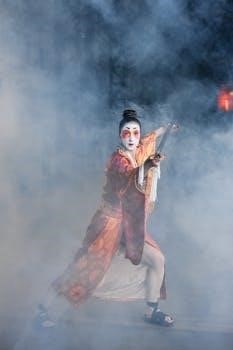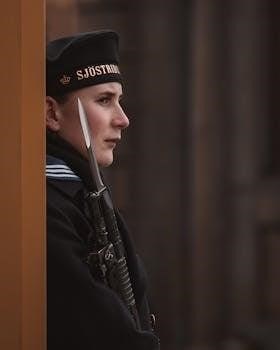Overview of ‘The Woman Warrior’
Maxine Hong Kingston’s The Woman Warrior is a groundbreaking work published in 1976 that blends memoir and Chinese folktales. It explores the lives of significant women in Kingston’s life, intertwining personal narrative with myths and legends, creating a unique autobiographical style.
Genre and Publication
The Woman Warrior defies easy genre classification, blending memoir, autobiography, and Chinese folktales. Published in 1976, it is subtitled “Memoirs of a Girlhood Among Ghosts,” which hints at its unique narrative style. The work is considered a landmark in Chinese-American literature and a crucial example of postmodern literature. Kingston’s innovative approach mixes personal experiences with fictional elements, creating a fluid and experimental text. It won the National Book Critics Circle Award for Nonfiction, highlighting its significance and impact. The book’s unique genre-bending approach made it a groundbreaking piece, challenging traditional literary conventions. It integrates elements of both personal reflection and traditional storytelling, resulting in a rich and complex narrative that continues to be studied. It is also considered a feminist work due to its focus on women’s experiences.
Autobiographical Elements
The autobiographical elements of The Woman Warrior are central to its power and impact. Maxine Hong Kingston, the narrator, shares her experiences growing up as a Chinese-American girl in California. She recounts her childhood, family life, and the challenges of navigating two distinct cultures. The narrative delves into her relationships with her mother, siblings, and the wider Chinese immigrant community. Kingston explores her struggle with identity, grappling with the expectations of both Chinese traditions and American society. The book reveals her inner thoughts, fears, and desires, offering a deeply personal account of her development. Kingston’s experience as the eldest of six children, while also believing her mother had two more children who died in China, also shapes the narrative. Her memories and reflections form the core of the work, making it a compelling and intimate portrayal of her life.

Key Female Figures
The Woman Warrior features several significant female figures, each contributing to the narrative’s exploration of womanhood. These characters include No Name Woman, Fa Mu Lan, and Brave Orchid. Their stories shape Kingston’s understanding of her heritage.
No Name Woman
The “No Name Woman” is Kingston’s aunt, whose story opens the memoir. This aunt, whose name is never spoken, is a figure shrouded in shame and secrecy due to her transgression of having an affair and bearing an illegitimate child. Kingston reimagines her aunt’s life, attempting to understand the circumstances that led to her tragic fate. This chapter explores the immense pressure placed upon women in traditional Chinese culture, where female transgressions are met with severe consequences. Kingston’s narrative is an attempt to give voice to a woman silenced by her family and society. This tale sets the stage for the larger themes explored throughout the book, such as the complexities of female identity, the impact of cultural expectations, and the power of storytelling to reclaim lost voices. It is a powerful introduction to the themes of silence, shame, and the difficulty of uncovering truths from the past.

Fa Mu Lan
The chapter dedicated to Fa Mu Lan presents a legendary figure of a female warrior, a myth that Kingston uses to explore themes of female empowerment. This section recounts the story of a woman who takes her father’s place in battle, becoming a skilled fighter and leader. Kingston imagines herself as Fa Mu Lan, using this fantasy to escape the limitations and expectations placed upon her as a Chinese-American girl. This narrative is a powerful exploration of the possibility of female agency and strength. It contrasts sharply with the story of the No Name Woman, offering a different perspective on female experience. The Fa Mu Lan story serves as a counter-narrative to the traditional roles imposed on women, providing Kingston with a sense of empowerment. It also highlights the importance of storytelling in shaping identity and challenging societal norms. The tale emphasizes the potential for women to be both feminine and fierce, warriors in their own right.
Brave Orchid
Brave Orchid, Kingston’s mother, is a central figure in “The Woman Warrior,” a complex character whose stories deeply influence Kingston’s understanding of her heritage and identity. Brave Orchid is presented as a powerful woman who carries the weight of tradition while navigating a new life in America. Her “talk-stories,” a blend of Chinese history, myths, and personal experiences, are the primary source of Kingston’s knowledge about her family’s past. She is portrayed as both a loving mother and a formidable figure, embodying strength and resilience in the face of cultural displacement. Her experiences, including her time at medical school in China and her life in America, highlight the challenges faced by immigrant women. Brave Orchid is the one who tells the story of No Name Woman and also shares the legend of Fa Mu Lan, shaping the narratives that define Kingston’s own identity. Through her, Kingston explores the complexities of motherhood, cultural heritage, and the immigrant experience.

Themes and Narrative Style
The Woman Warrior masterfully blends autobiography with mythology, exploring cultural identity through a unique narrative. Kingston’s style mixes personal experiences with Chinese folklore, creating a powerful and innovative literary form;

Blending of Autobiography and Mythology
Maxine Hong Kingston’s The Woman Warrior is renowned for its innovative blending of autobiographical elements with traditional Chinese mythology and folklore. This unique approach creates a narrative that is both deeply personal and culturally rich, allowing Kingston to explore her own experiences as a Chinese-American woman through the lens of her heritage. The text seamlessly interweaves stories from Kingston’s childhood with ancient tales, blurring the lines between reality and legend. This technique serves to highlight the complex interplay between individual identity and collective cultural narratives. By reimagining and reinterpreting these myths, Kingston not only reclaims her heritage but also challenges traditional notions of autobiography, creating a dynamic and multilayered narrative. The inclusion of these mythical stories provides a framework through which Kingston examines her own life and the lives of the women who came before her, revealing the powerful impact of both personal and cultural history. This fusion is a hallmark of Kingston’s work, making it a seminal text in the realm of both autobiographical and ethnic literature.
Exploration of Cultural Identity
A central theme in Maxine Hong Kingston’s The Woman Warrior is the complex exploration of cultural identity, specifically the challenges faced by Chinese-Americans growing up in the United States. Kingston grapples with the duality of her heritage, constantly navigating between the traditional Chinese values imparted by her family and the dominant American culture surrounding her. The narrative delves into the internal conflicts and external pressures experienced by those who exist within two distinct cultural worlds. Through her experiences and the stories of the women in her life, Kingston illuminates the struggles of assimilation and the search for a sense of belonging. She investigates how cultural expectations, particularly those concerning gender roles and family obligations, impact individual identity. The blending of personal narrative with Chinese folklore highlights the complexity of defining oneself when caught between two cultures. Ultimately, the work explores the process of forging a unique and hybrid identity that honors both her Chinese ancestry and her American upbringing, making it a powerful examination of cultural identity in a multicultural society.
Significance in Literature
The Woman Warrior holds significant importance in literature for its innovative blend of genres and its powerful exploration of cultural identity. Maxine Hong Kingston’s work is considered a landmark in Asian-American literature, offering a unique perspective on the experiences of Chinese immigrants in the United States. It broke new ground by seamlessly weaving together memoir, myth, and folklore, challenging traditional literary boundaries. The book’s exploration of female identity and the challenges faced by women within patriarchal structures has made it a cornerstone of feminist literature. Kingston’s narrative style, which incorporates both personal experiences and traditional Chinese storytelling, has influenced countless writers and expanded the possibilities of autobiographical writing. The book’s success in both critical acclaim and popular readership has brought greater visibility to the voices of marginalized communities and contributed to a more diverse literary landscape. Its lasting impact lies in its ability to speak to the universal themes of identity, family, and the search for belonging, while also highlighting the unique experiences of Chinese-Americans.

Leave a Reply
You must be logged in to post a comment.